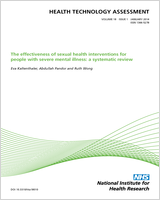Exercise for depression in care home residents: a randomised controlled trial with cost-effectiveness analysis (OPERA)
Health Technology Assessment, No. 17.18
Authors
M Underwood,,* SE Lamb, S Eldridge, B Sheehan, A Slowther, A Spencer, M Thorogood, N Atherton, SA Bremner, A Devine, K Diaz-Ordaz, DR Ellard, R Potter, K Spanjers, and SJC Taylor.Affiliations
Headline
Study finds no evidence to support the use of a whole-home physical activity and moderate-intensity exercise programme to reduce depression in elderly care home residents.
Abstract
Background:
Many older people living in care homes (long term residential care or nursing homes) are depressed. Exercise is a promising non-drug intervention for preventing and treating depression in this population.
Objective:
To evaluate the impact of a ‘whole-home’ intervention, consisting of training for residential and nursing home staff backed up with a twice-weekly, physiotherapist-led exercise class on depressive symptoms in care home residents.
Design:
A cluster randomised controlled trial with a cost-effectiveness analysis to compare (1) the prevalence of depression in intervention homes with that in control homes in all residents contributing data 12 months after homes were randomised (cross-sectional analysis); (2) the number of depressive symptoms at 6 months between intervention and control homes in residents who were depressed at pre-randomisation baseline assessment (depressed cohort comparison); and (3) the number of depressive symptoms at 12 months between intervention and control homes in all residents who were present at pre-randomisation baseline assessment (cohort comparison).
Setting:
Seventy-eight care homes in Coventry and Warwickshire and north-east London.
Participants:
Care home residents aged ≥ 65 years.
Interventions:
Control intervention: Depression awareness training programme for care home staff. Active intervention: A ‘whole-home’ exercise intervention, consisting of training for care home staff backed up with a twice-weekly, physiotherapist-led exercise group.
Main outcome measures:
Geriatric Depression Scale-15, proxy European Quality of Life-5 Dimensions (EQ-5D), cost-effectiveness from an National Health Service perspective, peripheral fractures and death.
Results:
We recruited a total of 1054 participants. Cross-sectional analysis: We obtained 595 Geriatric Depression Scale-15 scores and 724 proxy EQ-5D scores. For the cohort analyses we obtained 765 baseline Geriatric Depression Scale-15 scores and 776 proxy EQ-5D scores. Of the 781 who we assessed prior to randomisation, 765 provided a Geriatric Depression Scale-15 score. Of these 374 (49%) were depressed and constitute our depressed cohort. Resource-use and quality-adjusted life-year data, based on proxy EQ-5D, were available for 798 residents recruited prior to randomisation. We delivered 3191 group exercise sessions with 31,705 person attendances and an average group size of 10 (5.3 study participants and 4.6 non-study participants). On average, our participants attended around half of the possible sessions. No serious adverse events occurred during the group exercise sessions. In the cross-sectional analysis the odds for being depressed were 0.76 [95% confidence interval (CI) 0.53 to 1.09] lower in the intervention group at 12 months. The point estimates for benefit for both the cohort analysis (0.13, 95% CI −0.33 to 0.60) and depressed cohort (0.22, 95% CI −0.52 to 0.95) favoured the control intervention. There was no evidence of differences in fracture rates or mortality (odds ratio 1.07, 95% CI 0.79 to 1.48) between the two groups. There was no evidence of differences in the other outcomes between the two groups. Economic analysis: The additional National Health Service cost of the OPERA intervention was £374 per participant (95% CI −£655 to £1404); the mean difference in quality-adjusted life-year was −0.0014 (95% CI −0.0728 to 0.0699). The active intervention was thus dominated by the control intervention, which was more effective and less costly.
Conclusion:
The results do not support the use of a whole-home physical activity and moderate-intensity exercise programme to reduce depression in care home residents.
Trial registration:
Current Controlled Trials ISRCTN43769277.
Funding:
This project was funded by the National Institute for Health Research Health Technology Assessment programme and will be published in full in Health Technology Assessment; Vol. 17, No. 18. See the Health Technology Assessment programme website for further project information.
Article history paragraph text
The research reported in this issue of the journal was funded by the HTA programme as project number 06/02/01. The contractual start date was in February 2008. The draft report began editorial review in January 2012 and was accepted for publication in July 2012. The authors have been wholly responsible for all data collection, analysis and interpretation, and for writing up their work. The HTA editors and publisher have tried to ensure the accuracy of the authors' report and would like to thank the reviewers for their constructive comments on the draft document. However, they do not accept liability for damages or losses arising from material published in this report.
Included under terms of UK Non-commercial Government License.
